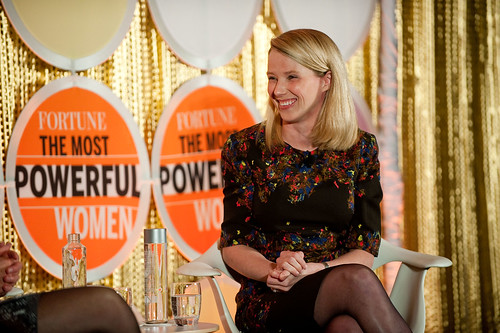Fortune Most Powerful Women Dinner With Marissa Mayer / Fortune Live Media
Although she'd received offers like that of Yahoo!'s before, this time was different. The company was a perfect fit for her experience. But as she says, "...it wasn’t a foregone conclusion that I would or could make it work when I got that first phone call. At the time, I was pregnant, and I was thrilled."
Motherhood is an oft-discussed topic for women in tech (and probably women everywhere). It can be difficult to be a pregnant woman among many men who don't necessarily understand what comes with that. Equally daunting is the prospect of taking time off for maternity leave when you'd be one of the few to do that in your company or perhaps in your position. (If there were more women in the field, it wouldn't seem like an uncommon occurrence.)
Mayer had been looking forward to a six-month maternity leave with Google, way longer than most Americans can even dream of. By taking the CEO job, she would cut her leave down to almost nothing. "The responsibilities were too big, and time was of the essence—it just wouldn’t be fair to the company, the employees, the board, or the shareholders for me to be in the role, but out for an extended period of time."
Did she find that motherhood has hurt her ability to be CEO?
I’ve come to realize that being a mother makes me a better executive, because motherhood forces prioritization. Being a mom gives you so much more clarity on what is important. I’m very close to my own mother; she has always been my most important role model. I’m grateful to her and to my father for a lifetime of their love, attention, teaching and sacrifice. Over the past five short months, my appreciation has grown for all parents, especially those balancing work obligations, because I know they have that same clarity of dedication and purpose.Clearly, it's not an issue. Granted, she has much money at her disposal to help keep her personal priorities. However, families around the world have been figuring out many different ways to make it work for many years. Money might make some things easier but it's not the only answer.
So can we stop bringing in the pregnancy and motherhood issue into discussions of women in tech (and other) companies? It's not like we ever do the same thing for men with young families.



